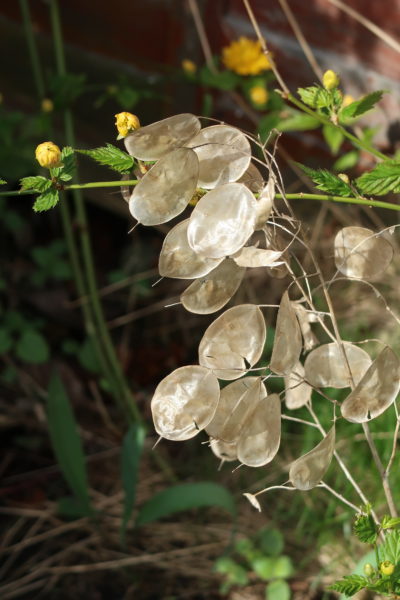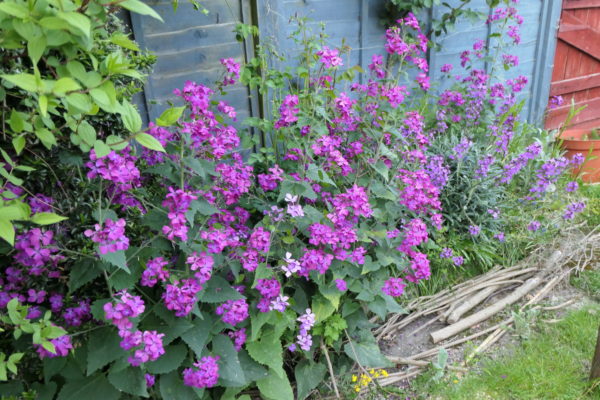
Gealach-lus
Tha aon lus, gu ìre mhòr fiadhain, as toil leam gu sònraichte faicinn sa ghàrradh aig an àm seo den bhliadhna, le a fhlùraichean purpaidh cùbhraidh ‘s a dhuilleagan mòra biorach – an gealach-lus, no “honesty” sa Bheurla. Chanadh cuid luibheanach ris, ach dhomsa ‘s e lus brèagha a th’ ann, a bheir dath dhan ghàrradh tràth sa bhliadhna, agus ùidh a bharrachd as t-fhoghar ‘s sa gheamhradh leis na buinn-airgid àlainn air.
‘S ann à ceann a deas na Roinn Eòrpa a tha e bho thùs, agus is cinnteach gun tàinig e do Bhreatainn ro dheireadh an 16mh linn, an toiseach mar fhlùr-gàrraidh, ach san eadar-àm tha e ri fhaicinn air feadh na dùthcha far a bheil an aimsir measarra – nochdaidh e ann am faichean, ri taobh an rathaid, agus anns na gàrraidhean againn. Ach na gabh dragh mura h-eil thu ga iarraidh an sin – tha e glè fhurasta an lus còmla ris a fhreumhan a tharraing a-mach. Cha dèan mise sin ach nuair a bhios cus ann, no nuair a bhios e a’ fàs san àite cheàrr, is mi cho measail air.
Nuair a tha thu a’ coimhead air, cha bhiodh tu a’ saoilsinn gur ann dhan teaghlach brassica a bhuineas e, còmhla ri càl, snèap, raip no mustard, ach seall gu dlùth agus tha na fluraichean den aon chruth. A rèir coltais faodaidh tu seòrsa mustaird a dhèanamh às na sìl, agus na duilleagan òga (mus nochd na fluraichean) a chleachdadh ann an sailead.
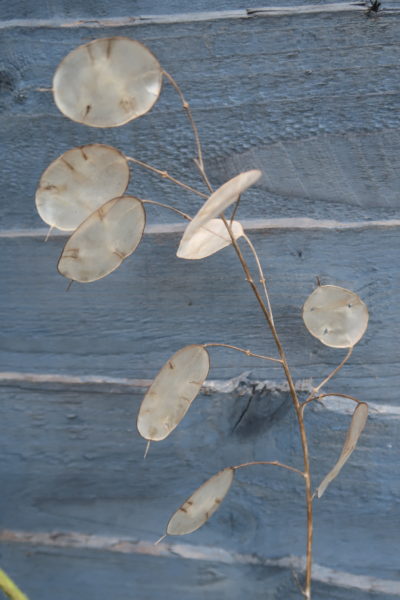
Ach ‘s ann airson rèiteachadh fhlùraichean a cleachdar iad mar as trice. Fhad’s a tha na flùraichean air an lus fhathast chì thu na siliques a’ fàs – is iad seo seòrsa sligich cruinne còmhnaird anns a bheil meamran leis na sìl. As t-earrach tha iad fhathast beag agus an aon dath ris na duilleagan agus mar sin cha bhi thu cho mothachail orra, ach tha na sìl rim faicinn mar-thà tron t-sligeach thrìd-dhealrach – ‘s ann air an adhbhar sin (mas fhìor) a fhuair an lus an t-ainm honesty, fìrinnteachd, is e a sealltainn a shìl gu firinneach. As t-fhoghar, nuair a tha na sligeachan tioram is na sìl deiseil ri sgaoileadh, thuitidh am plaosg a-muigh air falbh agus às a dhèidh na sìl bhon mheamran, agus chan eil ach am meamran fhèin air fhàgail, geal-airgid agus cho tana ri pàipear-sìoda. Tha iadsan gu h-iongantach buan, agus gu tric tha cuid air fhàgail gus an earrach. Dìreach ann an gruaim a’ gheamhraidh tha iad feumail is brèagha mar sgeadachadh.
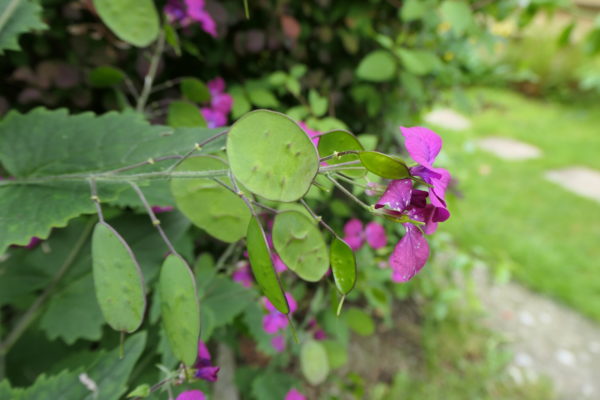
‘S e lunaria annua a th’ air an lus sa Laideann, bho luna, gealach, agus chì thu carson. Am measg nan ainmean Beurla tha cuideachd moonpennies, agus siniomradh air a’ choltas eile a th’ orra – ri buinn-airgid. Cluinnidh tu silver dollars orra cuideachd. Mar sin, le buaidh mhathasach na gealaich, geall soirbheachaidh nam bonn-airgid, agus a chliù firinnteachd, cò air talamh nach iarradh na lusan àlainn seo na ghàrradh? ‘S dòcha gum bi sibhse a’ coimhead orra le sùilean ùra a-nis. Tha mi an dòchas gum bi, co-dhiù!
++++++++++++++++++++++++++
Honesty
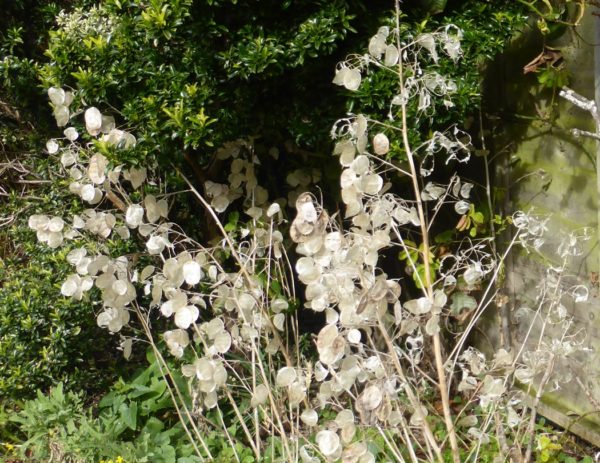
There’s one plant, more or less wild, which I particularly like to see in the garden at this time of year, with its fragrant purple flowers and its large pointed leaves – honesty (“moon-plant” in Gaelic). Some would call it a weed, but to me it’s a lovely plant which brings colour to the garden early in the year, and adds interest in autumn and winter with its beautiful silver “coins”.
It actually comes from southern Europe but has been in Britain since at least the end of the 16th century, first as a garden flower, and in the meantime all over the countryside, wherever the climate is moderate – it shows up in meadows, at the roadside and in our gardens. But don’t worry if you don’t want it there – it’s very easy to pull out, roots and all. Being so fond of it myself, I would only be doing that where there was too much of it, or it was in the wrong place.
When you look at it you wouldn’t automatically think that it’s in the brassica family, along with cabbage, turnip, rape or mustard, but look more closely at the flowers and you’ll see they’re the same form. Apparently you can make a kind of mustard out of the seeds, and use the young leaves (before the flowers come) in salad.
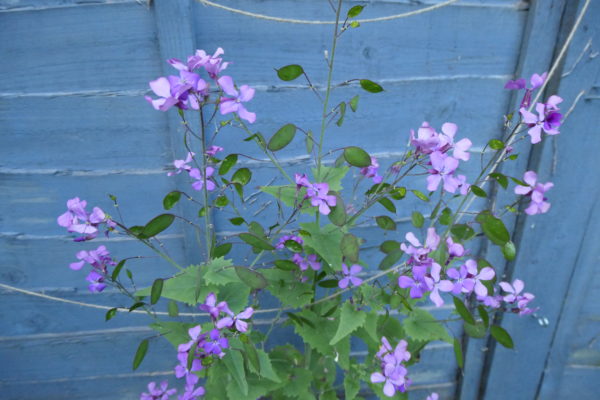
But it’s for flower arrangements that they’re most often used. While the flowers are still on the plant, you see the siliques appearing – they’re a kind of round, flat casing covering a membrane with the seeds attached inside it. In spring they’re still small and the same colour as the leaves, so you don’t notice them, but the seeds are already visible through the translucent casing – that’s allegedly the reason they’re called honesty, as they display their seeds so “truthfully”. In the autumn, when the siliques are dry and the seeds are ripe for spreading, the outer pod falls off, followed by the seeds dropping from the membrane, leaving the membrane itself in the round silique “frame”, silver-white and as thin as tissue-paper. These are amazingly long-lasting, and many often hang on until the spring. They’re especially useful and attractive as decoration in the gloom of winter.
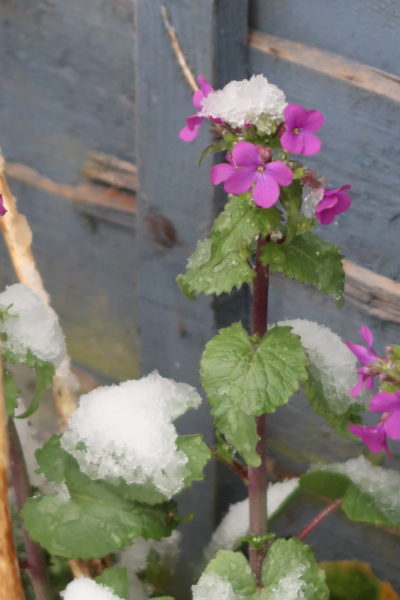
The Latin name is lunaria annua, from luna, the moon, and you can see why. Among the many English names the term “moonpennies” also refers to another similarity – to silver coins. You also hear the name “silver dollars”. So, with the benign influence of the moon, the promise of prosperity of the coins, and the reputation for truthfulness, who wouldn’t want these beautiful plants in their garden? Maybe you’ll look at them with fresh eyes now – I hope so, anyway!
